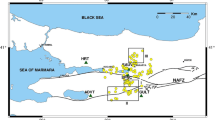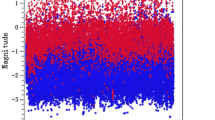Abstract
Different waveform-based discrimination parameters were tested using multivariate statistical analysis to develop a real-time procedure for discriminating explosions from earthquakes at regional distances in the Iberian Peninsula. This work enabled a purge of the Spanish National Seismic Catalogue for the period 2003–2014. The training data consisted of waveform-based signal properties in the time and frequency domain for events (earthquakes and explosions) recorded during the selected time period by the Spanish Broadband National Network and Sonseca short-period Array of the Instituto Geográfico Nacional (IGN). For each station and its associated training dataset, a discriminant function was defined as a linear combination of the measured variables. All station-specific discriminant functions were then combined with a weighting scheme to test the training events, revealing that 86 % of the events were consistent with the analysts’ judgement. The application of this method to the whole of the IGN’s seismic database for the studied period gave an 83 % success rate; however, a 91 % success rate is reached if events are classified using at least three stations and 100 % confidence levels.








Similar content being viewed by others
References
Allmann, B.P., Shearer, P.M., and Hauksson, E. (2008), Spectral discrimination between quarry blasts and earthquakes in southern California, Bull. Seismol. Soc. Am. 98, 2073–2079.
Anderson, D.N., Fagan, D.K., Tinker, M.A., Kraft, G.D., and Hutchenson, K.D. (2007), A mathematical statistics formulation of the teleseismic explosion identification problem with multiple discriminants. Bull. Seismol. Soc. Am. 97(5), 1730–1741.
Anderson, D.N., Walter, W.R., Fagan, D.K., Mercier, T.M., and Taylor, S.R. (2009), Regional Multistation Discriminants: Magnitude, Distance, and Amplitude Corrections, and Sources of Error. Bull. Seismol. Soc. Am. 99(2A), 794–808.
Baumgardt, D.R., and Ziegler, K.A. (1988), Spectral evidence for source multiplicity in explosions: application to regional discrimination of earthquakes and explosions, Bull. Seismol. Soc. Am. 78, 1773–1795.
Bennett, T.J., and Murphy, J.R. (1986), Analysis of seismic discrimination capabilities using regional data from western United States events, Bull. Seismol. Soc. Am. 76, 1069–1086.
Chernobay, I.P, and Gabsatarova, I.P. (1999), Source classification in the Northern Caucasus, Physics Earth and planet. Interiors, 113, 183–201.
Dowla, F.D., Taylor, S.R., and Anderson, R.W. (1990), Seismic discrimination with artificial neural networks: preliminary results with regional spectral data, Bull. Seismol. Soc. Am. 80, 1346–1373.
Esposito, A.M., Giudicepietro, F., Scarpetta, S., D’auria, L., Marinaro, M., and Martini, M. (2006), Automatic discrimination among landslide, explosion-quake, and microtremor seismic signals at Stromboli Volcano using neural networks, Bull. Seismol. Soc. Am. 96, 1230–1240.
Fäh, D., and Koch, K. (2002), Discrimination between earthquakes and chemical explosions by multivariate statistical analysis: A case study for Switzerland, Bull. Seismol. Soc. Am. 92, 1795–1805.
Farahani, J.V., Zare, M., and Lucas, C. (2012), Adaptive neuro-fuzzy interference systems for semiautomatic discrimination between seismic events: a study in Tehran region, J. of Seismol. 16, 291–303.
Fisher, R.A. (1936), The use of multiple measurements in taxonomic problems, Annals of Eugenics, 7, 179–188.
Hedlin, M.A., Minster, J. B., and Orcutt, J.A. (1989), The time-frequency characteristics of quarry blasts and calibration explosions recorded in Kazakhstan, USSR, Geophys. J. Int. 99, 109–121.
Koch, K. (2002a), Classification of local and regional events in central Europe based on estimates of S-wave spectral variance, Geophys. J. Int. 151, 196–208.
Koch, K. (2002b), Seismic Event Identification of Earthquakes and Explosions in Germany Using Spectral Lg Ratios. Pure appl. Geophys. 159, 759-778.
Koch, K., and Fäh, D. (2002), Identification of earthquakes and explosions using amplitude ratios: the Vogtland area revisited. Pure appl. Geophys. 159, 735–759.
Mezcua, J., Rueda, J. (1997), Seismological evidence for a delamination process in the lithosphere under the Alboran Sea, Geophys. J. Int., 129, F1–F8.
Muller, S., Garda, P., Muller, J.D., and Canci, Y. (1999), Seismic events discrimination by neuro-fuzzy merging of signal and catalogue features, Physics Chem. Earth. 24, 201–206.
Murphy, K.R., Mayeda, K., and Walter, W.R. (2009), Lg-coda methods applied to Nevada Test Site events: Spectral peaking and yield estimation, Bull. Seismol. Soc. Am. 99(1), 441–448.
Pomeroy, P.W., Best, W.J., and McEvilly, T.V. (1982), Test Ban Treaty verification with regional data: a review, Bull. Seismol. Soc. Am. 72, S89–S129.
Rueda, J. (2006). Discriminación sísmica mediante el análisis de las señales generadas por explosiones y terremotos. Aplicación a la región suroeste de Europa-Norte de África, Ph.D. Thesis, Universidad Politécnica de Madrid. Pp. 450.
Scarpetta, S., Giudicepietro, F., Ezin, E. C., Petrosino, S., Del Pezzo, E., Martini, M., and Marinaro, M. (2005), Automatic classification of seismic signals at Mt. Vesuvius volcano, Italy, using neural networks, Bull. Seismol. Soc. Am. 95, 185–196.
Stump, B.W., Hedlin, M.A., Pearson, D.C., and Hsu, V. (2002), Characterization of mining explosions at regional distances: implications with the international monitoring system, Rev. Geophys. 40, 1011.
Su, F., Aki, K., and Biswas, N.N. (1991), Discriminating quarry blasts from earthquakes using coda waves, Bull. Seismol. Soc. Am. 81, 162–178.
Taylor, S.R., Sherman, N.W., and Denny, M. (1988), Spectral discrimination between NTS explosions and western United States earthquakes at regional distances, Bull. Seismol. Soc. Am. 78, 1563–1579.
Taylor, S.R. (1996), Analysis of high-frequency Pg/Lg ratios from NTS explosions and western U.S. Earthquakes, Bull. Seismol. Soc. Am. 86, 1042–1053.
Walter, W.R., Mayeda, K.M., and Patton, H.J. (1995), Phase and spectral ratio discrimination between NTS earthquakes and explosions. Part I: Empirical observations, Bull. Seismol. Soc. Am. 85, 1050–1067.
Wüster, J. (1993), Discrimination of chemical explosions and earthquakes in central Europe—a case study, Bull. Seismol. Soc. Am. 83, 1184–1212.
Wüster, J. (1995), Discrimination of earthquakes and industrial explosions in the Vogtland Region and NW-Bohemia, Ph.D. Thesis, Ruhr-University Bochum, Series A, No.42.
Acknowledgments
We would like to thank the Instituto Geográfico Nacional of Spain for providing the data for the study. We appreciate the valuable comments of the anonymous reviewers, which helped to improve the manuscript.
Author information
Authors and Affiliations
Corresponding author
Rights and permissions
About this article
Cite this article
García Vargas, M., Rueda, J., García Blanco, R.M. et al. A Real-Time Discrimination System of Earthquakes and Explosions for the Mainland Spanish Seismic Network. Pure Appl. Geophys. 174, 213–228 (2017). https://doi.org/10.1007/s00024-016-1330-z
Received:
Accepted:
Published:
Issue Date:
DOI: https://doi.org/10.1007/s00024-016-1330-z




